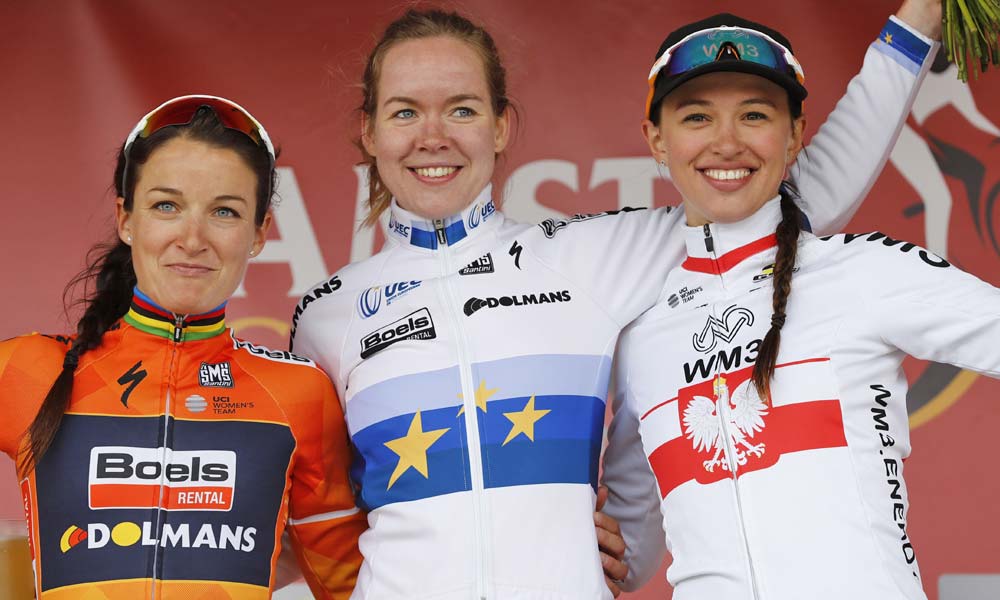[et_pb_section bb_built=”1″ admin_label=”section”][et_pb_row admin_label=”row” background_position=”top_left” background_repeat=”repeat” background_size=”initial”][et_pb_column type=”1_4″][et_pb_text background_layout=”light” use_border_color=”off” border_color=”#ffffff” border_style=”solid” _builder_version=”3.0.93″]
There’s a lot more to pro cycling than just riding a bike. Tune in long enough and you may even pick up a foreign phrase or two… or even learn a different language. We delve into the RIDE archives to remind ourselves about some Polish pronunciation.
[/et_pb_text][/et_pb_column][et_pb_column type=”3_4″][et_pb_text background_layout=”light” use_border_color=”off” border_color=”#ffffff” border_style=”solid” _builder_version=”3.0.93″]
We’ve talked about talking about cycling in the past but let’s now go a step further and get to know some of the particulars about another of the sport’s many languages: Polish.
– By Jakub Zimoch
With cyclists from Poland becoming more and more visible in the peloton, many commentators and fans literally twist their tongues trying to pronounce their names. Polish is considered as one of the most difficult languages in the world. It has, for example, nouns that can have three genders, seven cases for nouns and adjectives, and verbs that come in two aspects and conjugate for gender, person and time.
It is not an easy task to master Polish and it should be left for mighty creatures living over the Vistula River.
Henry Miller once wrote that spoken Polish puts him in ecstasy, he continued: “They hissed their long polychromatic words through tiny, sensual mouths whose lips were soft as geraniums. These furious sorties with adders and rose petals made an intoxicating sort of music, a steel-gibber which could also register anomalous sounds like sobs and falling jets of water.”
Luckily, some simple linguistic tricks will make you shine in the cycling community when speaking about Polish riders.
The language is based on standard Latin alphabet, with some ‘special’ letters. You may have noticed some of them with dashes or dots, some of them with little tails. However similar looking, they are not accents, but mean separate sounds.
Polish can really twist your tongue sometimes but, thankfully, the rules are very simple.
[/et_pb_text][/et_pb_column][/et_pb_row][et_pb_row][et_pb_column type=”4_4″][et_pb_image show_in_lightbox=”off” url_new_window=”off” use_overlay=”off” animation=”left” sticky=”off” align=”left” force_fullwidth=”off” always_center_on_mobile=”on” use_border_color=”off” border_color=”#ffffff” border_style=”solid” _builder_version=”3.0.93″ src=”https://www.ridemedia.com.au/wp-content/uploads/2018/04/Niewiadoma-CanyonSRAM.jpg” show_bottom_space=”on” /][/et_pb_column][/et_pb_row][et_pb_row][et_pb_column type=”1_4″][et_pb_text background_layout=”light” use_border_color=”off” border_color=”#ffffff” border_style=”solid” _builder_version=”3.0.93″]
‘Kasia’ Niewiadoma (above) has finished Flèche Wallonne in 5th (2015), 4th (2016) and 3rd (2017)… she is the leader of the Canyon-SRAM team for the 2018 edition. Photo: courtesy Canyon-SRAM
Michał Kwiatkowski (below) is another Polish rider who we can expect to see in action at the front of the peloton in La Flèche Wallonne. Photo: Yuzuru Sunada
[/et_pb_text][/et_pb_column][et_pb_column type=”3_4″][et_pb_text background_layout=”light” use_border_color=”off” border_color=”#ffffff” border_style=”solid” _builder_version=”3.0.93″]
Unlike in English, Polish is phonetic language, meaning that you always pronounce letters or their combinations in the same way.
Most consonants are pronounced the same in both languages, the only exceptions are ‘c’ which sounds like ‘ts’ and ‘j’ which should be pronounced like English ‘y’ in “yes”.
The rules for vowels are simple:
- ‘a’ as in “car”
- ‘e’ as in “met”
- ‘i’ like “feet”
- ‘o’ as in “cord”
- ‘u’ or ‘ó’ like in “book”
- ‘y’ like i in “sit” or in “myth”
Let us start with some simple stuff for practice: Rafał Majka.
First thing you notice is a modified ‘l’ with a slash across it: ł. You read it like ‘w’ in “will”: “Ra-faw”. Then, comes “Majka”, which you should read as “Mayka”. Great, now you can greet the “Bison of Zegartowice”!
The same weird ł appears in other names like “Michał”. Here comes first simple letter combination: ‘ch’ which you pronounce just like ‘h’ – do not worry, Polish kids also hate the existence of both ‘h’ and ‘ch’ in primary school.
Since we are here considering the sound of Michał, let’s move onto his surname: Kwiatkowski – you pronounce this like “Kviat-ko-ski”. The ‘ski’ sounds exactly like winter sport.
Another name with ł is Łukasz, which you should pronounce like “Woo-kash”.
When you see the combination of ‘s’ or ‘c’ with ‘z’, you read it respectively “sh” or “tsh”.
In 2018 Łukasz Wiśniowski rides for Team Sky. When he was with the Belgian Quickstep team and I bet they had some problems with his surname and ‘ś’, but apply some Polish logic and it’s quite simple: Vee-shnee-oski.
Letters with a dash like ‘ś’, ‘ć’ or ‘ź’ and combinations like si, ci and zi should be pronounced as extremely soft “sh” or “tsh” and followed by a short “ee” sound. This is one of the trickiest sounds to produce by a non-native, so do not get upset if you cannot make it. There is also no similar word or sound in English to illustrate the principle. It will be still fine if you just forget about a dash and read standard ‘s’ (Vee-snee-oski) or ‘c’ like in “Maciej”: “Ma-tsee-ey”.
Here we come to the famous rustles and swishes – or the “sounds like sobs and falling jets of water” of the Polish language: “Przemysław”. After an easy “P” there is another letter combo producing sound of hard “zh”, like in Zhivago and the same sound should be made when you encounter ‘ż’. So finally, it is “Pzhe-mis-wav”.
The only Przemysław you probably know from pro peloton is Przemysław Niemiec from UAE Team Emiriate: “Nee-emi-ets”. There’s the same “rz” you will find in the very common girl’s name: “Katarzyna”, but now you know it is “Ka-ta-zhi-na”.
In some names you may encounter ‘a’ and ‘e’ with small tails: ‘ą’ and ‘ę’, these are nasal vowels.
The easiest way to tackle those is to read ‘ą’ like “om”, and ‘ę’ like “en”.
There is also ‘ń’ or “ni”, which are soft versions of ‘n’, like in French “Montagne” or Vuelta a España. Just try Niewiadoma: “Nye-vya-doma”.
Before you go out and show off to your friends with your new-found linguistic skills, spend some time practising over this sentence: “w Szczebrzeszynie chrząszcz brzmi w trzcinie i Szczebrzeszyn z tego słynie”.
– By Jakub Zimoch
[/et_pb_text][/et_pb_column][/et_pb_row][et_pb_row][et_pb_column type=”4_4″][et_pb_image show_in_lightbox=”off” url_new_window=”off” use_overlay=”off” animation=”left” sticky=”off” align=”left” force_fullwidth=”off” always_center_on_mobile=”on” use_border_color=”off” border_color=”#ffffff” border_style=”solid” _builder_version=”3.0.93″ src=”https://www.ridemedia.com.au/wp-content/uploads/2018/04/KWIATKOWSKI.jpg” show_bottom_space=”on” /][/et_pb_column][/et_pb_row][/et_pb_section]



